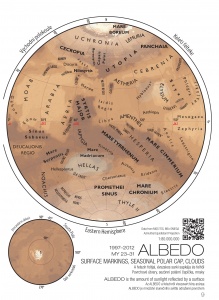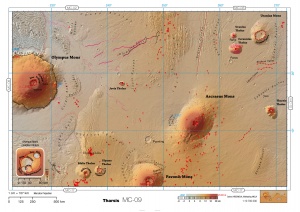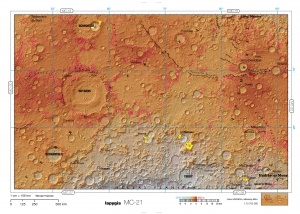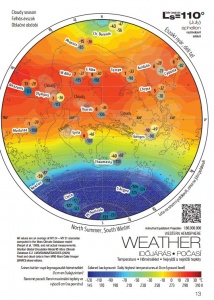Press Release: A Pocket Guide to Mars
A pocket atlas of Mars has been published that uses geographic techniques developed for terrestrial maps to reveal a wealth of information about the surface of the Red Planet, as well as its climate and cloud cover. The atlas is being presented this week at the 52nd Lunar and Planetary Science Conference.
The 84-page atlas is currently available in English, Hungarian and Czech, and will be available in a digital format later this year. The atlas, which has been developed for use in astronomy clubs and schools, was funded by the Europlanet Society through its Central European Hub.
The main part of the atlas consists of a series of double spreads showing each of the 30 cartographic quadrangles into which the surface of Mars has been divided by the US Geological Survey. The landforms created by lava, wind, water, and ice are shown separately on a topographic base map, highlighting features such as dune fields, mountain peaks, volcanic calderas, caves, ancient dried-up lakes and deltas, and fault lines.
For the first time in a published Mars atlas, climate maps are included, which show 13 climatic zones with boundaries defined by combining seasonal temperature and frost data. A series of climate diagrams show the variation in temperature through the martian year for each of the zones. In addition, a weather map shows the temperature at ground level across the western hemisphere of Mars at the two annual solstices.
The atlas also includes an albedo map, derived from data from Mars Express and Mars Global Surveyor, which shows the amount of sunlight reflected from the surface, the frequently cloudy regions and the maximum area covered by the seasonal caps of frozen carbon dioxide and water ice at the martian poles.
The map editor, Henrik Hargitai of the Eötvös Loránd University, Budapest and former chair of the Commission on Planetary Cartography of the International Cartographic Association, said: “The maps in the atlas are manually edited, using accurate data from missions and models. Thematic maps that reveal patterns in physical geography have been used for decades for in terrestrial atlases, but this is the first time that they are available in an atlas for Mars. The publication of this edition is a culmination of mapping efforts over the last two decades. The atlas also includes a one-page calendar for Mars year 36, covering the period from February 2021 to December 2022, which explains the milestones in the seasonal changes on Mars.”
Future plans for the atlas include the addition of themed maps that show regions of interest in detail, and atlas-based activities for educators. As well as being a tool for outreach and education, this type of multi-themed map could be valuable for the scientific community in interpreting the geologic evolution of Mars, estimating whether an area might ever have hosted life, or identifying in-situ resources to support future human exploration missions.
Images




Further Information
Henrik Hargitai will present the atlas in a live session at LPSC 2021 on 17 March 2021 at 18:00 CET.
The Pocket Atlas of Mars: A Public Outreach Project, H I Hargitai, LPSC 2021.
Iposter: https://lpsc2021.ipostersessions.com/?s=44-38-3F-AD-C3-BA-23-34-9F-D5-5E-2A-F5-C7-ED-9D
Abstract: https://www.hou.usra.edu/meetings/lpsc2021/pdf/2109.pdf
The atlas is available at: https://www.etsy.com/listing/955444239/mars-36-pocket-atlas
Media Contact
Anita Heward
Press Officer
Europlanet 2024 Research Infrastructure
+44 7756034243aheward@europlanet-society.org
Notes for Editors
About Europlanet
Since 2005, Europlanet has provided Europe’s planetary science community with a platform to exchange ideas and personnel, share research tools, data and facilities, define key science goals for the future, and engage stakeholders, policy makers and European citizens with planetary science.
The Europlanet 2024 Research Infrastructure (RI) has received funding from the European Union’s Horizon 2020 research and innovation programme under grant agreement No 871149 to provide access to state-of-the-art research facilities and a mechanism to coordinate Europe’s planetary science community. The project builds on a €2 million Framework 6 Coordination Action (EuroPlaNet), a €6 million Framework 7 Research Infrastructure (Europlanet RI) and a €10 million Horizon 2020 Research Infrastructure (Europlanet 2020 RI) funded by the European Commission.
The Europlanet Society promotes the advancement of European planetary science and related fields for the benefit of the community and is open to individual and organisational members. The Society’s aims are:
- To expand and support a diverse and inclusive planetary community across Europe through the activities of its 10 Regional Hubs.
- To build the profile of the sector through outreach, education and policy activities
- To underpin the key role Europe plays in planetary science through developing links at a national and international level.
Europlanet 2024 RI project website: www.europlanet-2024-ri.eu
Europlanet Society website: www.europlanet-society.org
Follow on Twitter via @europlanetmedia

